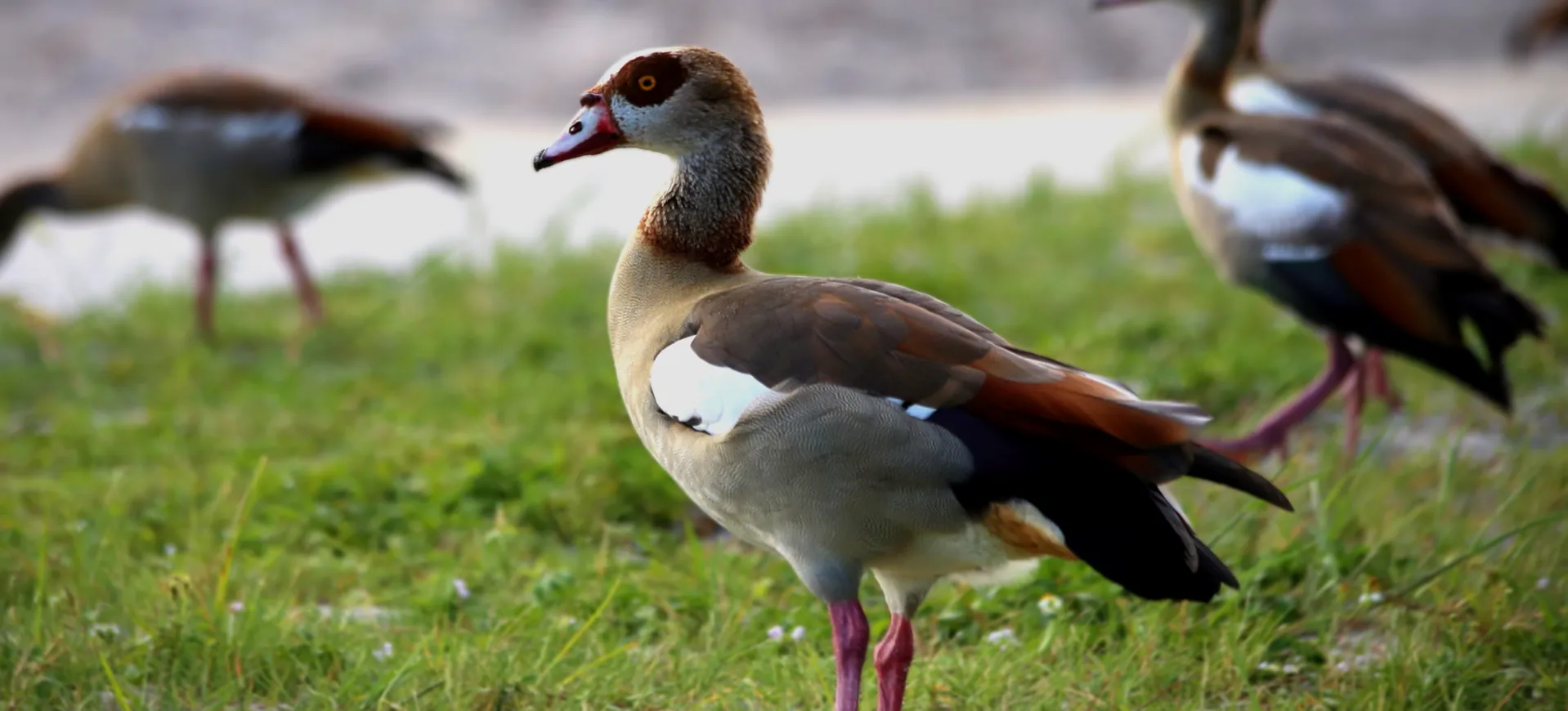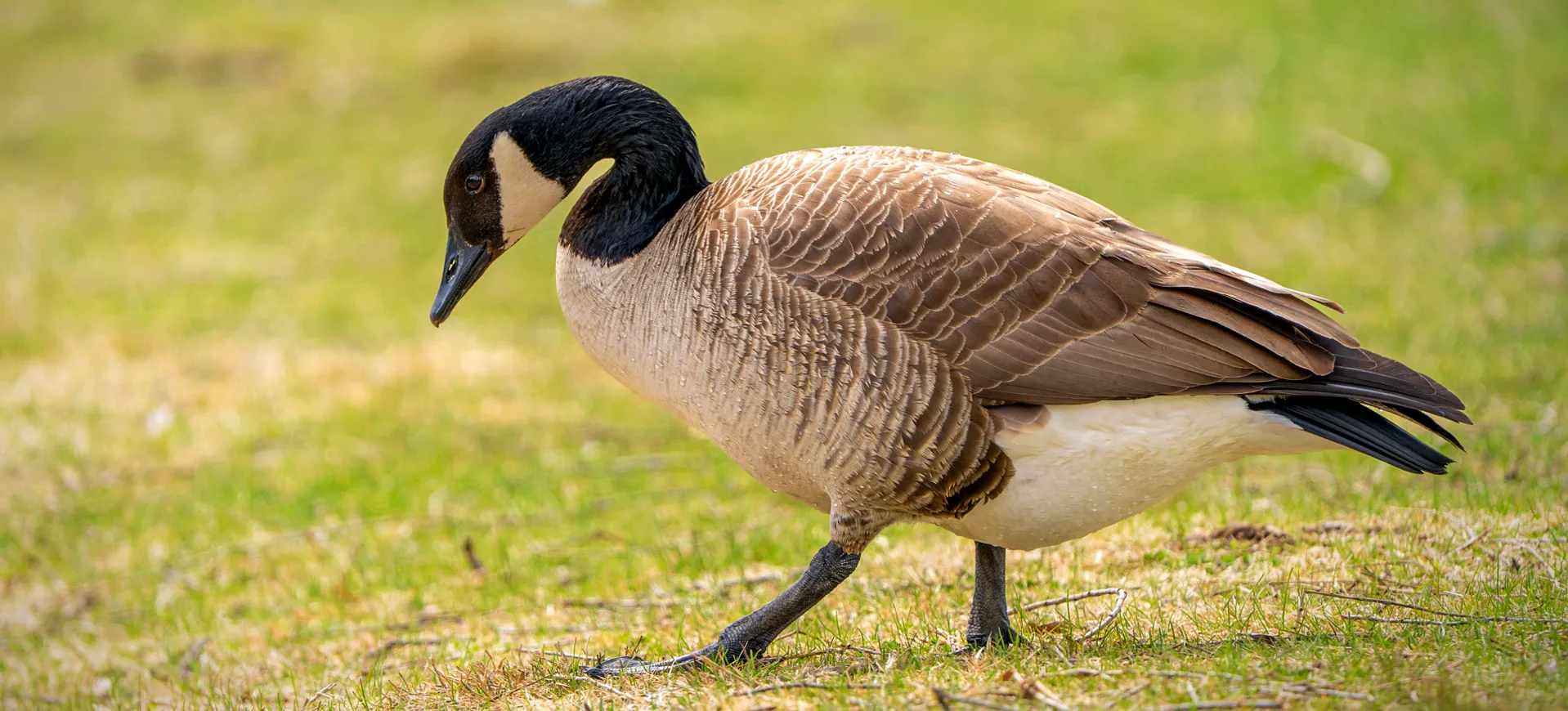Overview
Mandarin Ducks are esteemed for their extraordinary beauty and are native to East Asia. The males are particularly noted for their vibrant colors and elaborate plumage, featuring a mix of blues, greens, and oranges, complemented by distinctive white eye patches and sail-like feathers. Females, while more subdued in color, possess their elegance with a mottled brown appearance that provides camouflage among the forest’s underbrush and water edges. These ducks favor calm, sheltered waters surrounded by dense foliage, where they can feed, mate, and nest away from predators.
Mandarin Ducks are symbols of fidelity and affection in many cultures, reflecting their monogamous pair bonds formed during the breeding season. They are adaptable feeders, with diets ranging from aquatic plants to small insects and fish, showcasing their omnivorous nature. The species prefers nesting in tree cavities near water bodies, which aids in the protection of their eggs and fledgling ducklings from ground-based predators. Despite their beauty and cultural significance, Mandarin Ducks face threats from habitat loss, pollution, and hunting, which impact their wild populations.
Mandarin Ducks are unique in folklore and art, representing love and marital happiness, especially in Chinese and Japanese cultures. Their presence in the wild is a testament to East Asia’s diverse and rich ecosystems, but conservation efforts are necessary to ensure their habitats are preserved. Captive breeding programs and wildlife protection laws contribute to their survival, alongside educational initiatives to reduce pollution and habitat destruction. These efforts are crucial for maintaining the delicate balance within their native ecosystems and securing the future of the Mandarin Duck.
Taxonomy
Kingdom
Phylum
Class
Order
Family
Genus
Species
Type
Physical Description:
The male Mandarin Duck is celebrated for its striking beauty during the breeding season, displaying an array of bright colors and distinctive markings, including blue-green wings, orange plumes, and white eye stripes. Their elaborate plumage serves not only as a means to attract mates but also reflects the species’ health and vitality. Females, in contrast, are dressed in more modest attire, featuring a predominately mottled brown plumage that excellently camouflages them in their natural environment. This difference in appearance between genders is a classic example of sexual dimorphism, common among many bird species.
Outside the breeding season, male Mandarin Ducks undergo a molt that leaves them looking similar to females, a phenomenon known as eclipse plumage, which provides added protection from predators by blending more seamlessly into their surroundings. Both males and females share a sleek body shape, indicative of their agility in water and air, facilitating quick escapes from threats. Their compact size aids in maneuverability through dense forest habitats and narrow waterways, where they frequently forage and nest. The species’ physical attributes play crucial roles in survival and reproduction, from the distinctive color patterns to the aerodynamic body shape.

Lifespan: Wild: ~6 Years || Captivity: ~10 Years

Weight: Male: 1.3-2.5 lbs (0.6-1.1 kg) || Female: 1.1-2.2 lbs (0.5-1.0 kg)

Length: Male & Female: 21-24.5 in (53.3-62.2 cm)

Height: Male & Female: 16-19 in (41-49 cm)

Wingspan: Male & Female: 26-30 in (66-76 cm)

Top Speed: 30 mph (48 km/h)
Characteristic:
Native Habitat:
Mandarin Ducks originate from East Asia’s temperate and subtropical forests, where they inhabit rivers, lakes, and ponds surrounded by dense vegetation. This habitat preference provides them with the necessary cover from predators and access to various food sources, essential for their omnivorous diet. The availability of tree cavities for nesting is a critical factor in their habitat selection, as these natural structures offer protection for their eggs and young. The intricate balance of their ecosystem supports not only the Mandarin Ducks but also a wide range of other species, highlighting the interconnectedness of these habitats.
The destruction of wetlands and forests poses a significant threat to their natural habitats, leading to a decline in suitable nesting and feeding areas. Conservation efforts focused on habitat preservation and restoration are vital for the survival of Mandarin Ducks in the wild. These efforts include the protection of water bodies from pollution and managing forests to ensure the availability of nesting sites. Environmental education and awareness campaigns are also crucial in mitigating the impact of human activity on these delicate ecosystems, ensuring that future generations can continue to enjoy the presence of Mandarin Ducks in their natural habitats.
Climate Zones:
Biomes:
Biogeographical Realms:
Countries:
Diet:
Diet & Feeding Habits:
Mandarin Ducks are omnivores, consuming a varied diet that includes seeds, nuts, plants, insects, and small fish. This dietary flexibility allows them to adapt to different seasons and available food sources, optimizing their nutritional intake throughout the year. They typically feed by dabbling on the water’s surface or foraging along its edge, rarely diving deep for food. This feeding behavior underscores their adaptation to shallow water environments and their preference for easily accessible food items.
In captivity, their diet is carefully managed to mimic natural feeding patterns as closely as possible, including a balanced mix of plant-based foods and proteins. This ensures the ducks maintain a healthy weight and nutrient level, which is especially important for breeding pairs to produce viable eggs. The feeding habits of Mandarin Ducks also play a role in the dispersion of plant seeds, contributing to the health of their aquatic ecosystems. Conservation programs often include habitat restoration efforts to ensure these ducks have access to ample feeding grounds, supporting both the species and the broader biodiversity of their habitats.
Mating Behavior:
Mating Description:
Mandarin Ducks are monogamous, forming pair bonds throughout the breeding season. During courtship, males display their colorful plumage and engage in elaborate behaviors to attract females, including vocal calls and physical displays. These rituals emphasize the male’s health and vitality, crucial factors in the female’s mate selection process. The strong pair bonds and cooperative behaviors observed in Mandarin Ducks during the breeding season indicate the species’ complex social and mating systems.
Nesting occurs in tree cavities near water, where the female lays and incubates her eggs. The secluded nature of these nesting sites offers protection from predators and environmental elements, ensuring a higher survival rate for the offspring. Following hatching, ducklings quickly become independent, leaving the nest within hours to follow their mother to water. This early independence is vital for their survival, as it reduces predation risk and allows them to begin foraging for food under the mother’s guidance.
Reproduction Season:
Birth Type:
Pregnancy Duration:
Female Name:
Male Name:
Baby Name:
Social Structure Description:
Mandarin Ducks exhibit a complex social structure that varies throughout the year. During the breeding season, they are predominantly monogamous, forming strong pair bonds that play a crucial role in reproductive success. Establishing and maintaining these bonds involves various behaviors, from vocal communication to mutual preening. Outside of the breeding season, Mandarin Ducks may gather in larger groups, especially during migration or in communal roosting sites, demonstrating a more social aspect of their behavior.
The social dynamics of Mandarin Ducks are influenced by their environment, with factors such as food availability and predator presence affecting their interactions. Ducks may exhibit more tolerance towards each other in areas where resources are abundant, while in resource-scarce environments, competition can lead to more aggressive behaviors. The ability of Mandarin Ducks to adapt their social structure based on environmental conditions is a testament to their resilience and flexibility as a species. Understanding these dynamics is important for conservation efforts, as it informs habitat management and protection strategies that support the natural behaviors of the ducks.
Groups:
Conservation Status:
Population Trend:
The global population of Mandarin Ducks is not precisely quantified, but the species is currently classified as Least Concern by the IUCN, indicating a relatively stable population overall. However, localized declines have been observed, primarily due to habitat loss, degradation, and hunting pressures. These challenges highlight the need for continued monitoring and conservation efforts to ensure the species does not move towards a more threatened status. The adaptability of Mandarin Ducks to various habitats has been a key factor in their survival, but this does not lessen the importance of protecting their natural environments.
In both their native and introduced ranges, Mandarin Ducks face different sets of challenges. In their native habitats, the primary concerns include deforestation, pollution, and disturbance from human activity. In areas where they have been introduced, issues revolve around their impact on local ecosystems and competition with native species. Conservation strategies are therefore tailored to address the specific needs and threats faced by populations in different regions, ensuring that efforts to protect the Mandarin Duck are effective and sustainable.
Population Threats:
Habitat destruction and alteration due to human activities are the primary threats facing Mandarin Ducks. The loss of wetlands and forests reduces the availability of nesting sites and food sources, directly impacting their ability to reproduce and sustain their populations. Pollution and climate change further exacerbate these threats, altering the ecosystems upon which the ducks depend. Hunting and the pet trade also pose significant risks, leading to a direct decrease in wild populations and disrupting natural behaviors.
Conservation efforts to mitigate these threats include habitat protection and restoration, legal protections against hunting and capture, and public education campaigns to raise awareness about the species and its plight. International cooperation is essential, as many threats to Mandarin Ducks cross national boundaries. Effective conservation strategies must, therefore, encompass a range of actions, from local habitat management to global policy initiatives, to ensure the species’ long-term survival.
Conservation Efforts:
Conservation efforts for Mandarin Ducks focus on habitat preservation, legal protection, and public education. Protected areas and wildlife reserves are crucial in safeguarding critical habitats, while laws and regulations aim to reduce hunting and trade pressures. Captive breeding programs contribute to the conservation of the species by maintaining genetically diverse populations and, in some cases, supporting reintroduction efforts. Public education and awareness campaigns are vital for changing behaviors that threaten the ducks, such as pollution and habitat destruction.
Collaboration between governments, conservation organizations, and local communities is key to the success of these efforts. Community-based conservation initiatives that involve local stakeholders in habitat management and protection have shown promise in balancing human needs with wildlife conservation. Research and monitoring are ongoing to better understand the needs of Mandarin Ducks and the threats they face, informing conservation strategies and ensuring they are based on the latest scientific knowledge. Together, these efforts aim to secure a future for Mandarin Ducks in their native and introduced ranges, preserving their beauty and ecological role for generations.
Additional Resources:
Fun Facts
- Mandarin Ducks are symbols of love and fidelity in many Asian cultures.
- Unlike most ducks, Mandarins prefer to nest in tree cavities.
- The male’s elaborate plumage is shed after the breeding season, leading to a more subdued eclipse plumage.
- Ducklings are capable of jumping from considerable heights without injury shortly after hatching.
- Mandarin Ducks do not quack; their calls are more whistle-like or squeaky.
- They are one of the few duck species that can perch in trees.
- In Korea, Mandarin Ducks are featured in wedding ceremonies as a symbol of marital harmony.
- The species has been introduced to various countries where they live in wild populations.
- Mandarin Ducks are considered a delicacy in some cultures.
- They have been featured in Asia’s art, literature, and folklore for centuries.
















































































